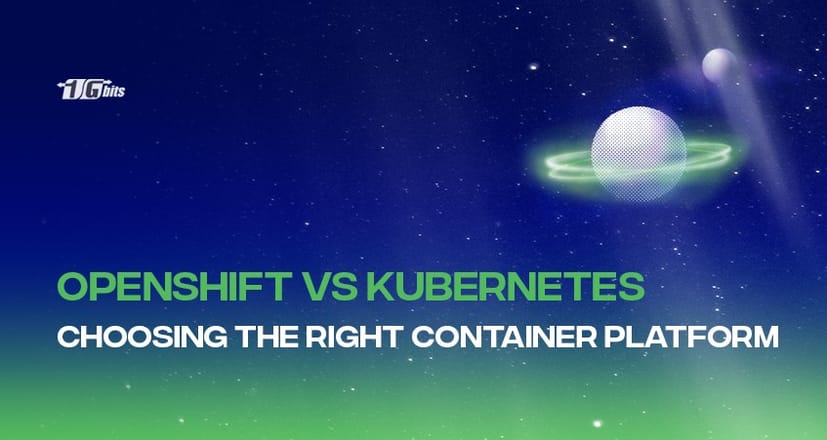Choosing between OpenShift and Kubernetes depends on the specific needs and priorities of the organization. Both platforms have strengths and weaknesses; their choice will depend on the use case and the organization's requirements. OpenShift and Kubernetes are powerful and widely used platforms for managing containerized workloads. Organizations should evaluate their specific requirements, technical expertise, and budget to determine which platform best fits their needs.
What is OpenShift?
OpenShift is a container application platform developed by Red Hat. It is a cloud-based platform that helps organizations build, deploy, and manage containerized applications. OpenShift is built on top of Kubernetes, an open-source container orchestration platform. It provides a developer-friendly interface allowing developers to create and deploy applications in containers quickly. OpenShift also provides features such as automated scaling, rolling updates, and load balancing, making it easier to manage and scale applications.
OpenShift supports a wide range of programming languages, frameworks, and databases, and it can be deployed on-premises or in the cloud. It also includes a range of tools for continuous integration and deployment (CI/CD), making automating the application development process easier. Overall, OpenShift is a powerful platform for developing, deploying, and managing containerized applications, and it is used by many organizations worldwide to build and run their applications.
Kubernetes, also known as K8s, is an open-source container orchestration platform. It was originally developed by Google and is now maintained by the Cloud Native Computing Foundation (CNCF). Kubernetes is used for automating containerised applications' deployment, scaling, and management.
Background of OpenShift
OpenShift was originally developed by a company called Red Hat, now an IBM subsidiary. The platform was first released in 2011 and has undergone multiple updates and improvements. Red Hat developed OpenShift to help organizations build, deploy, and manage containerized applications. The platform is built on top of Kubernetes and provides additional tools and features to make it easier to manage containerized workloads.
OpenShift is both a cloud-based service and a self-managed, on-premises platform. It has become a popular choice for organizations of all sizes looking for an easy-to-use, scalable, and flexible platform for developing and deploying applications in containers.
What is Kubernetes?
In Kubernetes, containers are organized into pods, the smallest deployable units in the system. Pods can contain one or more containers and share network and storage resources. Kubernetes also provides features such as automatic load balancing, self-healing, and scaling, making it easier to manage containerized applications at scale.
Kubernetes is highly modular and extensible, with a large ecosystem of plugins and extensions that can be used to add additional functionality. It can run on various cloud providers and on-premises environments, making it a versatile platform for managing containerized workloads. Overall, Kubernetes has become the de facto standard for container orchestration and is widely used in production environments by organizations of all sizes. Its popularity is due to its powerful features, extensibility, and community support, making it an excellent choice for managing large-scale containerised applications.
Background of Kubernetes
Google originally developed Kubernetes as an internal project for managing their containerized workloads. The project was originally called "Borg" and was used by Google for over a decade to manage their massive-scale production workloads. In 2014, Google released the Kubernetes project as an open-source project under the Apache 2.0 license.
Since its release, Kubernetes has become one of the most popular open-source projects in the world, with a large and growing community of contributors and users. The project is now managed by the Cloud Native Computing Foundation (CNCF), a nonprofit organization that promotes using cloud-native technologies, including Kubernetes. Kubernetes has become the de facto standard for container orchestration and is widely used by organizations of all sizes to manage their containerized workloads. Its popularity is due to its powerful features, flexibility, and extensibility and the large and growing ecosystem of tools and plugins developed around it.
Overall, Kubernetes has significantly impacted the development and adoption of cloud-native technologies. It is likely to remain a key part of the infrastructure for many organizations in the years to come.
OpenShift vs Kubernetes
OpenShift and Kubernetes are related but distinct technologies with some key differences. OpenShift is a container application platform developed by Red Hat, while Kubernetes is an open-source container orchestration platform originally developed by Google. OpenShift is built on top of Kubernetes, so it includes all of the core features of Kubernetes, plus additional tools and features to make it easier to manage containerized workloads.
One of the main differences between OpenShift and Kubernetes is their focus. OpenShift is primarily designed to be a complete platform for building, deploying, and managing containerized applications. It includes various additional tools and features, such as an integrated development environment (IDE), a source code management system, and a continuous integration and delivery (CI/CD) pipeline. Kubernetes, on the other hand, is primarily focused on container orchestration and provides a powerful set of features for managing containerized workloads.
Another key difference between OpenShift and Kubernetes is their ease of use. OpenShift is designed to be more developer-friendly and easier to use than Kubernetes, with a user interface that makes it easier to manage applications and workloads. Kubernetes, on the other hand, is more complex and requires more technical expertise to manage effectively.
In summary, while OpenShift and Kubernetes are related technologies, they have different focuses and strengths. OpenShift is designed to be a complete platform for building and managing containerized applications, while Kubernetes is focused primarily on container orchestration. Both platforms have their strengths and weaknesses, and the choice between them will depend on the specific needs and priorities of the organization.
Strengths and weaknesses of OpenShift vs Kubernetes
OpenShift and Kubernetes have different strengths and weaknesses, which should be considered when choosing between them.
Advantage of OpenShift
Ease of use: OpenShift has a more user-friendly interface than Kubernetes, which makes it easier for developers to manage applications and workloads.
Additional tools and features: OpenShift includes a range of additional tools and features, such as an integrated development environment (IDE), source code management, and a CI/CD pipeline, which makes it a complete platform for building and managing containerized applications.
Support and services: OpenShift is developed and supported by Red Hat, providing customers with various services and support options.
Disadvantage of OpenShift
Cost: OpenShift is a commercial product requiring a subscription, which may make it less accessible to small organizations or those with limited budgets.
Customization: OpenShift is designed to be a complete platform with specific features, which may make it less flexible and customizable than Kubernetes.
Advantage of Kubernetes
Flexibility and extensibility: Kubernetes is highly modular and extensible, with a large ecosystem of plugins and extensions that can be used to add additional functionality. This makes it highly adaptable to various use cases and environments.
Open-source and community-driven: Kubernetes is an open-source project with a large and active community of contributors and users, which means that it is constantly being updated and improved based on feedback from the community.
Widely adopted: Kubernetes is the de facto standard for container orchestration and is widely adopted by organizations of all sizes.
Disadvantage of Kubernetes
Complexity: Kubernetes can be complex and requires more technical expertise to manage effectively than OpenShift.
Lack of additional tools and features: Kubernetes primarily focuses on container orchestration and does not include the same range of additional tools and features as OpenShift, which may make it less suitable for organizations that need a complete platform to build and manage containerized applications.
OpenShift vs Kubernetes, which one is better?
Deciding whether OpenShift or Kubernetes is better depends on the specific needs and priorities of the organization. Both platforms have strengths and weaknesses; the choice between them will depend on the use case and the organization's requirements. If the organization needs a complete platform for building, deploying, and managing containerized applications, and values ease of use, additional tools and features, and support and services, OpenShift may be the better choice.
If the organization needs a highly flexible and extensible container orchestration platform and values open-source software and community-driven development, Kubernetes may be the better choice. OpenShift and Kubernetes are powerful and widely used platforms for managing containerized workloads. Organizations should evaluate their specific requirements, technical expertise, and budget to determine which platform best fits their needs.
People also read:










